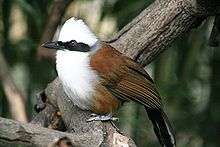Garrulax
Garrulax is a genus of passerine birds in the family Leiothrichidae.
| Garrulax | |
|---|---|
 | |
| White-crested laughingthrush (Garrulax leucolophus) | |
| Scientific classification | |
| Kingdom: | Animalia |
| Phylum: | Chordata |
| Class: | Aves |
| Order: | Passeriformes |
| Family: | Leiothrichidae |
| Genus: | Garrulax Lesson, 1831 |
| Species | |
|
See text | |
| Synonyms | |
Taxonomy
The genus Garrulax was erected by the French naturalist René Lesson in 1831.[1] The type species was designated in 1961 as the rufous-fronted laughingthrush (Garrulax rufifrons).[2] The name of the genus is from the Latin garrulus "babbling".[3]
The genus previously included more species. Following the publication of a comprehensive molecular phylogenetic study in 2018, Garrulax was split up and species were moved to the resurrected genera Ianthocincla and Pterorhinus.[4][5]
Garrulax species are heavily traded as songbirds. A survey of eight bird markets in Indonesia, carried out in 2014–2015, found 615 laughingthrushes of nine species openly for sale.[6] Much of the trade in these species in Indonesia is illegal and is pushing a number of these species towards extinction.[7]
Species
The genus contains the following 14 species:[5]
- Lesser necklaced laughingthrush, Garrulax monileger
- Rufous-fronted laughingthrush, Garrulax rufifrons
- White-crested laughingthrush, Garrulax leucolophus
- Black-hooded laughingthrush, Garrulax milleti
- Sumatran laughingthrush, Garrulax bicolor
- White-necked laughingthrush, Garrulax strepitans
- Cambodian laughingthrush, Garrulax ferrarius
- Grey laughingthrush, Garrulax maesi
- Rufous-cheeked laughingthrush, Garrulax castanotis
- Sunda laughingthrush, Garrulax palliatus
- Chinese hwamei, Garrulax canorus
- Taiwan hwamei, Garrulax taewanus
- Spot-breasted laughingthrush, Garrulax merulinus
- Orange-breasted laughingthrush, Garrulax annamensis
References
| Wikimedia Commons has media related to Garrulax. |
| Wikispecies has information related to Garrulax |
- Lesson, René (1831). Traité d'Ornithologie, ou Tableau Méthodique (in French). Paris: F.G. Levrault. p. 647.
- Mayr, Ernst; Paynter, Raymond A. Jr, eds. (1964). Check-list of Birds of the World. Volume 10. Cambridge, Massachusetts: Museum of Comparative Zoology. p. 348.
- Jobling, J.A. (2018). del Hoyo, J.; Elliott, A.; Sargatal, J.; Christie, D.A.; de Juana, E. (eds.). "Key to Scientific Names in Ornithology". Handbook of the Birds of the World Alive. Lynx Edicions. Retrieved 21 March 2018.
- Cibois, A.; Gelang, M.; Alström, P.; Pasquet, E.; Fjeldså, J.; Ericson, P.G.P.; Olsson, U. (2018). "Comprehensive phylogeny of the laughingthrushes and allies (Aves, Leiothrichidae) and a proposal for a revised taxonomy". Zoologica Scripta. 47 (4): 428–440. doi:10.1111/zsc.12296.
- Gill, Frank; Donsker, David, eds. (2019). "Laughingthrushes and allies". World Bird List Version 9.1. International Ornithologists' Union. Retrieved 16 January 2019.
- Shepherd et al. (2016)
- Shepherd (2010)
- Collar, N. J. & Robson C. 2007. Family Timaliidae (Babblers) pp. 70 – 291 in; del Hoyo, J., Elliott, A. & Christie, D.A. eds. Handbook of the Birds of the World, Vol. 12. Picathartes to Tits and Chickadees. Lynx Edicions, Barcelona.
- Shepherd, C. R. (2010). Observations on trade in laughingthrushes (Garrulax spp.) in North Sumatra, Indonesia. Bird Conservation International, 21 (1): 86–91.
- Shepherd, C. R., Eaton, J. A. and Chng, S. C. L. (2016). Nothing to laugh about – the ongoing illegal trade in laughingthrushes (Garrulax species) in the bird markets of Java, Indonesia. Bird Conservation International, 26(4): 524–530.